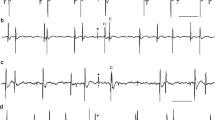Summary
Gastrocnemius motoneurones with different types of muscle unit were compared with respect to their repetitive discharges during 4 min periods of steady intracellular stimulation. The cells were activated by a constant injected current of 5 nA above threshold. Among neurones capable of discharging for 10 s or more, the discharge duration showed no significant correlation to the contraction time or amplitude of the muscle unit twitch. Neither was there any obvious correlation between discharge duration and the sensitivity to contractile fatigue. The slow drop in discharge rate, as measured from the 2nd to the 26th s of firing, was more pronounced for fast-twitch units than for the ones with a slower twitch. Among fast-twitch neurones with about the same initial discharge rate, no difference in the extent of slow frequency drop was found between cells with fatigue-resistant and fatigue-sensitive muscle units. For fast-twitch neurones, measurements and calculations showed that, if the effects of peripheral potentiation and fatigue were disregarded, the drop in firing rate was great enough to cause a decrease in force by more than 60% during the first minute of constant stimulation. Among the fast-twitch units studied, the mean recorded fall in contractile force was initially less than expected (potentiation dominating) and it had become about equal to the expected one at 1 min after the onset of the discharge. It is concluded that, particularly with respect to fast-twitch motoneurones, the late adaptation is likely to be a significant factor for the development of central “fatigue” in voluntary or reflex contractions. Thanks to their small amount of late adaptation, slow-twitch motoneurones are par ticularly suitable for producing a steady postural contraction.
Similar content being viewed by others
References
Bagust J, Lewis DM, Luck JC (1974) Post-tetanic effects in motor units of fast and slow twitch muscle of the cat. J Physiol (Lond) 237: 115–121
Bigland-Ritchie B, Lippold OCJ (1979) Changes in muscle activation during prolonged maximal voluntary contractions. J Physiol (Lond) 292: 14–15P
Burke RE (1967) Motor unit types of cat triceps surae muscle. J Physiol (Lond) 193: 141–160
Burke RE (1979) The role of synaptic organization in the control of motor unit activity during movement. Prog Brain Res 50: 61–67
Burke RE, Nelson PG (1971) Accommodation to current ramps in motoneurons of fast and slow twitch motor units. Int J Neurosci 1: 347–356
Burke RE, Levine DN, Tsairis P, Zajac PE (1973) Physiological types and histochemical profiles in motor units of the cat gastrocnemius. J Physiol (Lond) 234: 723–748
Denny-Brown D (1929) On the nature of postural reflexes. Proc R Soc Lond [Biol] 104: 252–301
Eccles JC, Eccles RM, Lundberg A (1958) The action potentials of alpha motoneurones supplying fast and slow muscles. J Physiol (Lond) 142: 275–291
Grimby L, Hannerz J, Hedman B (1979) Contraction time and voluntary discharge properties of individual short toe extensor motor units in man. J Physiol (Lond) 289: 191–201
Grimby L, Hannerz J, Hedman B (1981) The fatigue and voluntary discharge properties of single motor units in man. J Physiol (Lond) 316: 545–554
Holloszy JO, Booth FW (1976) Biochemical adaptations to endurance exercise in muscle. Ann Rev Physiol 38: 273–291
Jones DA, Bigland-Ritchie B, Edwards RHT (1979) Excitation frequency and muscle fatigue: mechanical responses during voluntary and stimulated contractions. Exp Neurol 64: 401–413
Kernell D (1965a) The adaptation and the relation between discharge frequency and current strength of cat lumbosacral motoneurones stimulated by long-lasting injected currents. Acta Physiol Scand 65: 65–73
Kernell D (1965b) The limits of firing frequency in cat lumbosacral motoneurones possessing different time course of afterhyper-polarization. Acta Physiol Scand 65: 87–100
Kernell D (1979) Rhythmic properties of motoneurones innervating muscle fibres of different speed in m.gastrocnemius medialis of the cat. Brain Res 160: 159–162
Kernell D, Monster AW (1982) Time course and properties of late adaptation in spinal motoneurones of the cat. Exp Brain Res 46: 191–196
Kernell D, Sjöholm H (1973) Repetitive impulse firing: comparisons between neurone models based on ‘voltage clamp equations’ and spinal motoneurones. Acta Physiol Scand 87: 40–56
Kernell D, Ducati A, Sjöholm H (1975) Properties of motor units in the first deep lumbrical muscle of the cat's foot. Brain Res 98: 37–55
Marsden CD, Meadows JC, Merton PA (1971) Isolated single motor units in human muscle and their rate of discharge during maximal voluntary effort. J Physiol (Lond) 217: 12–13P
McCloskey DI (1978) Kinesthetic sensibility. Physiol Rev 58: 763–820
Mishelevich DJ (1969) Repetitive firing to current in cat motoneurons as a function of muscle unit twitch type. Exp Neurol 25: 401–409
Person RS, Kudina LP (1972) Discharge frequency and discharge pattern of human motor units during voluntary contraction of muscle. Electroencephalogr Clin Neurophysiol 32: 471–483
Reinking RM, Stephens JA, Stuart DG (1975) The motor units of cat medial gastrocnemius. Problems of their categorisation on the basis of mechanical properties. Exp Brain Res 23: 301–313
Sasaki K, Otani T (1961) Accommodation in spinal motoneurons of the cat. Jpn J Physiol 11: 443–456
Schwindt PC (1973) Membrane-potential trajectories underlying motoneuron rhythmic firing at high rates. J Neurophysiol 36: 434–449
Stephens JA, Stuart DG (1975) The motor units of cat medial gastrocnemius. Twitch potentiation and twitch-tetanus ratio. Pflügers Arch 356: 359–372
Author information
Authors and Affiliations
Additional information
Supported by NIHNS 11574 during this work
Rights and permissions
About this article
Cite this article
Kernell, D., Monster, A.W. Motoneurone properties and motor fatigue. Exp Brain Res 46, 197–204 (1982). https://doi.org/10.1007/BF00237177
Received:
Published:
Issue Date:
DOI: https://doi.org/10.1007/BF00237177




